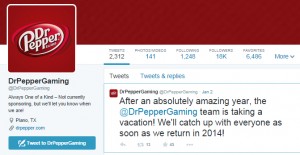I’ve been called a “Twitter Guru” by several friends and colleagues, but I have always figured that to mean: “You use Twitter more than I do.” This is likely true, but I scoff since I am nowhere near old-man-on-a-mountain-top status. In fact, even with all the time I’ve spent with the platform, I feel like I’ve hardly maximized on ALL of the possibilities provided by their services.
During the 2013 e-sports season I worked as the community manager for Dr Pepper on their partnership campaign with Major League Gaming. For 10 months I was the voice of @DrPepperGaming, reaching out to gamers, competition professionals, teams, organizations, commentators, and hosts. We ended the season with over 18,000 followers and even though corporate eventually dropped the program, we left quite the impression on the gaming community at large.

Outside of drafting conversations focused on the most engaging content possible, I spent most of my time tracking data and analytics about the campaign to share with the regional managers responsible for the program. When I wasn’t building a content calendar for the next month or live tweeting along with streamed events our community was watching, I would collect the “F@RT” numbers (yep, that’s actually what we called them) from some of our most successful ideas, promotions, or outreach incentives.
F@RT stands for: Favorites, At Replies, and Retweets and these numbers were the bare minimum that our client wanted to see in order to engage some degree of ROI. However, these numbers only ever scratched the surface at showing the company the value of what was happening online. On my computer I have hundreds of screen grabs from interesting conversations, photos fans would take of them with the product while playing their consoles or watching a match with friends, and tons of notebook paper scrawled with tally marks and frequency percentages that would show where the most interaction was coming from.
During my time with the account, I always felt like Twitter could be doing so much more in offering tracking tools in order to pull the numbers or capture the story an account was creating. Many social community websites have detailed insights or analytics built directly into their platforms, but we don’t see Twitter offering this to users on the back-end.
With so many socially or politically motivated Twitter campaigns and movements, it would be incredibly beneficial if Twitter, themselves, offered up a solution in order to measure the numbers directly from an account without having to use third-party support. I am looking forward to speaking with Simon Rogers in class and hope to discuss some of his ideas for how Twitter can help us tell better stories using our data. Not just for the public, but for our clients as well.
A few questions for Simon:
What are some of the analytics that you feel are the most important at telling a story or evaluating the real success of a campaign?
What sorts of data scraping tools do you think Twitter should provide their users on the back-end?
What third-party tools do you think are the best for collecting data from the platform?
Is it possible to really tell a story in 140 characters or less?